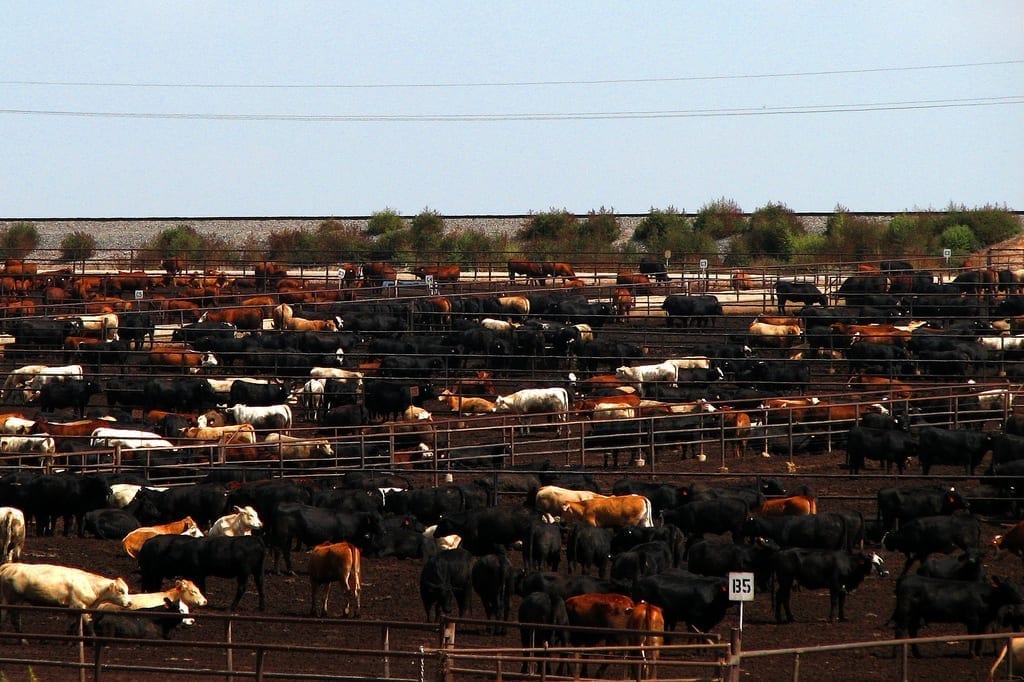Ever drive out in the country where livestock feedlots saturate the air with ammonia so thick that your nose hairs practically wither? Where I come from, that and the ever-present earthy smell of manure were euphemistically called “fresh country air.” These industrial feedlot exhalations aren’t just stinky, though: they are a potent source of pollution. Solving this problem seems like a good way for the Environmental Protection Agency (EPA) to make itself useful, but in 2008, the EPA decided that CAFOs didn’t have to report their pollutants. Last week, though, the D.C. Court of Appeals vacated that rule, saying that Congress had not given the EPA the authority to create CERCLA exemptions as they pleased. Now, CAFOs and other massively polluting livestock operations will be required, like everyone else, to answer to all of us for their pollution problems.
Ever drive out in the country where livestock feedlots saturate the air with ammonia so thick that your nose hairs practically wither? Where I come from, that and the ever-present earthy smell of manure were euphemistically called fresh country air. It was bad enough to have to close the car windows for a summertime drive-by; I can scarcely imagine having to live near a Concentrated Animal Feeding Operation (CAFO). These industrial feedlot exhalations aren’t just stinky, they are a potent source of pollution.
Rounding up livestock into centralized, confined areas to fatten them for slaughter may be incredibly efficient from a business standpoint, but it also turns what used to be an asset into a dangerous liability. For generations, farmers on diversified smallholdings (picture the sorts of happy farms you see on product labels or in children’s books) have used manure as a rich fertilizer that helped return to the fields the nutrients we take away in the form of food. As the economy grew and more people started wanting inexpensive meat as an everyday staple, though, farmers found feedlots an ideal way to soak up excess commodity corn. Now, instead of dropping dookie right in the field where reasonable amounts are reabsorbed by the soil, hundreds or thousands of cows or pigs together can produce as much waste every day as a small city. Now imagine all of that rolling downhill into a “lagoon” instead of getting flushed away to the water treatment plant. What a mess!
According to the Centers for Disease Control and Prevention (CDC), CAFO messes contaminate groundwater, foul that fresh country air with gaseous and particulate matter (giving neighbors asthma), breed nuisance insects, set the stage for antibiotic resistant bacteria, reduce property values, and contribute to climate change. Cheap meat becomes rather expensive when all of the costs are figured in, but those costs are easier to ignore when you’re not paying for them directly.
Solving these problems seems like a good way for the Environmental Protection Agency (EPA) to make itself useful. In 2008-2009, though, the EPA (still under the outgoing President George W. Bush) exempted such farms from having to report polluting levels of animal waste emissions under the Comprehensive Environmental Response, Compensation and Liability Act (CERCLA). What were they thinking? Apparently the EPA thought that there wasn’t anything they were able (or willing) to do to mitigate or prevent pollution from CAFOs, so why bother?

After the rule was finalized, the Sierra Club and Waterkeeper Alliance filed suit with the U.S. Court of Appeals for the District of Columbia. The National Pork Producers Council also filed suit, claiming in part that the EPA, by issuing this guidance the day before the deadline for filing emissions reports, had deliberately undermined farmers’ ability to comply with the original rule. After years of delays and foot-dragging on the part of the EPA, the non-profit environmental law organization Earthjustice was able to go to court on behalf of communities suffering from the noxious effects of their local CAFO’s emissions. It was time to clear that fresh country air.
Finally, last week, a breath of relief! The D.C. Court of Appeals vacated that rule, saying that Congress had not given the EPA the authority to create CERCLA exemptions as they pleased. Now, CAFOs and other massively polluting livestock operations will be required, like everyone else, to answer to all of us when they foul our air with potentially lethal ammonia fumes, hydrogen sulfide (that rotten egg stink), and the rest of their unwholesome bouquet. Even if the EPA chooses not to protect us from these particular pollutants (and why not?), there is value in knowing where and when they happen, because folks, air gets around, we all have to breathe it, and it’s not like poisons go away if we don’t measure them.
This ruling might not get the cows out of the CAFO and back onto diversified smallholdings where they belong (let alone put the bison back on the plains), but it’s a step in the right direction as far as cleaning up their mess and figuring the honest cost of industrialized food production. And maybe, just maybe, it will bring back some fresh country air.
Related: Milk By Any Other Name


Join the conversation!